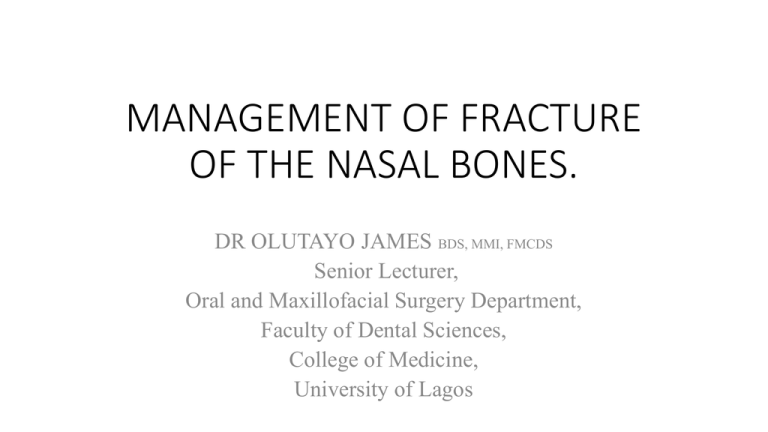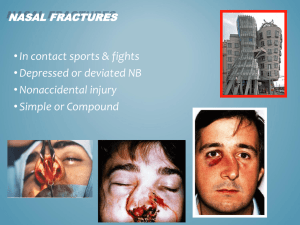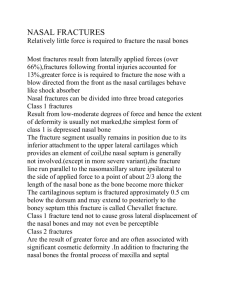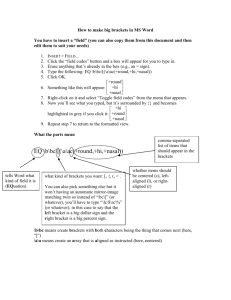Document
advertisement

MANAGEMENT OF FRACTURE OF THE NASAL BONES. DR OLUTAYO JAMES BDS, MMI, FMCDS Senior Lecturer, Oral and Maxillofacial Surgery Department, Faculty of Dental Sciences, College of Medicine, University of Lagos Surgical Anatomy • The nasal bone is one important bone of the nasoorbitoethmoidal (NOE) complex • The skeletal foundation of NOE complex consists of a strong triangular frame . • On each side of the triangle ,the frontal process of the maxillary bone and the nasal process of the frontal bone are united above at the glabella by the frontal bone . • The triangle is completed inferiorly by premaxilla The nasoorbitoethmoidal (NOE) complex The nasoorbitoethmoidal (NOE) complex Nasal Complex 1) Osseous framework – Paired Nasal bones 2) Cartilaginous framework The upper lateral cartilage The lower lateral cartilage The lobular or Alar cartilage. 3) The septum, which is comprised of cartilage and bone. Osseous Frame work • • • • • Consist of Two nasal bones Convex from above downward Convex from side to side Their length varies from 8 to 33 mm Width superiorly varies from 2 to17 mm and inferiorly from 7 to 24 mm. • The inner surfaces are concave form side to side and traversed above downward by a groove for the anterior ethmoidal nerve Osseous Frame work • The paired nasal bones articulate in the midline with each other (internasal suture) • Laterally, both borders articulates with the frontal process of the maxillae (Naso-maxillary suture) • The superior border is thick and serrated and articulates with the nasal process of the frontal bone. (Naso-frontal Suture) Osseous Frame work Osseous Frame work • The thinner, caudal portion of the nasal bones is notched and articulates with the upper lateral cartilages. • This area is vulnerable to fracture and dislocation. Nasal Complex Osseous Frame work • Medially where the two bones articulates with one another, they are thicker above than bellow and are prolonged posteriorly to form a vertical crest • This form part of the septum of the nose and articulates from above downward with the nasal spine of the frontal bone, the perpendicular plate of the ethmoid and the cartilage of the nasal septum Cartilaginous Framework- Upper nasal Cartilage • Trapezoid in shape – wrongly term "triangular cartilage". • Its anterior margin is thicker than the posterior and the upper part is continuous with the cartilage of the septum • Lower part is separated from this cartilage by a narrow fissure • The superior margin is attached to the nasal bone and frontal process of maxillae Nasal Complex - Cartilaginous Framework Blood suply FRACTURE OF THE NASAL BONES Nasal fractures • The third most common fracture of the human skeleton • The most commonly fractured bony structures of the maxillofacial complex • Likewise, the most commonly missed facial fracture • Protruding position coupled with its relative lack of support • May include associated fractures of the nasal cartilages and/or the nasal septum. • They may be associated with fractures of the ascending process of the maxilla. • They can often occur in association with NOE and frontal sinus Nasal fractures Epidemiology • Nasal fractures account for greater than 50% of all facial fractures in adults • Brazil - nasal fractures were also most common facial injuries, (51.3%), followed by the zygomatic-orbital complex (25.4%).(Cavalcanti and Melo) • Nigeria - ?? Clinical Significance • Most nasal fractures cause significant bleeding. • Proper techniques for hemostasis should be applied prior to any diagnostic procedure and any definitive treatment. • Prompt appropriate treatment to prevents functional and cosmetic changes. • Because of the nose's central location and proximity to important structures, the clinician should carefully search for other facial injuries in the presence of facial fractures. Aetiology • Blunt trauma – sport injury, RTC, physical altercations Personal injury • High velocity injuries – blasts, gun shot Signs and Symptoms • • • • • • • Facial oedema Billateral circumorbital ecchymosis Subconjuctival ecchymosis Deviation of nose Epistaxis / caked clotted blood CSF leakage Nasal blockage r/o pre-existing nasal deformities Classification • There is no standardized, world-wide accepted classification for nasal fractures. • Ondik et al 2009 and AO provide a simple classification systems based on clinical findings Ondik et al 2009 AO Classification : Laterally displaced fractures • Occur secondary to a lateral blow to the nose. • The nasal bones are pushed medially on the side of the impact and laterally on the contralateral side. • They make up the majority of nasal fractures. • Most of them can be managed by closed reduction. Posteriorly depressed fractures • Posteriorly depressed fractures occur secondary to a direct blow over the nasal bones, • which are pushed inside to the ascending process of the maxilla. • The nasal septum is always involved. • This type of fracture can be associated with NOE fractures. Disarticulation of upper lateral cartilage • A disarticulation of upper lateral cartilage • Usually due to a localized strong blow to the central third of the nose, as in car accidents with the steering wheel hitting the nose. • The upper lateral cartilage can be avulsed from the bone. Anterior nasal spine fracture • Can occur in isolation or in association with other nasal fractures. • Displaced fractures are often associated with nasal septum dislocations and/or fractures. • Occurs in association to degloving injuries of the upper labial vestibule as in a steering wheel injury. • Isolated anterior nasal spine fractures do not usually require treatment. Nasal septum dislocations and/or fractures • The nasal septum is almost always involved in nasal fractures and must be evaluated to determine if treatment is necessary. • If the impact force is weak, nasal bone displacement is usually present without septal fractures. • With more significant forces the septum will be fractured. • Nasal septal injuries often lead to nasal airway compromise. • The need for repair is individualized based on the patient’s symptoms. • Septal injuries may result in a loss of support of the cartilaginous nasal dorsum which can require cosmetic reconstruction. Diagnosis • History of the patient, physical examination and imaging. • The direction and strength of the impact should be noted. • Pre-existing nasal or septal deformities should also be considered. • A history of nasal bleeding may indicate a mucosal laceration. • Skin laceration over the nasal area may guide fracture diagnosis to the specific anatomical area. Physical examination Intranasal anatomy assessment • Done using a nasal speculum, looking for a septal deviation, mucosal laceration and/or septal hematoma. • The presence of a significant septal hematoma requires immediate drainage. Septal hematomas • • • • • • This is a common and serious complication of nasal trauma. These are collections of blood in the subperichondrial space. This places pressure on the underlying cartilage Resulting in irreversible necrosis of the septum. The patient also becomes predisposed to infection. A saddle deformity may develop from loss of tissue. Septal hematomas : • The main symptom is severe nasal obstruction • On examination the septum appears swollen and boggy • The swollen area should be palpated with a cotton-tipped applicator. • If a hematoma is present it should be compressible. • The presence of a significant septal hematoma requires immediate drainage. Septal hematomas: Drainage procedure • Septal hematomas must be drained immediately upon their being found. • Cotton pledgets soaked in 2% lignocaine are used for topical anesthesia. • A scalpel incision must be made to allow drainage. • A small Penrose-type drain is placed to prevent re-accumulation. • Finally, nasal packing is placed. • The patient should be started on oral antibiotics Imaging • Plain films of the nose. • The greatest weakness of plain films is their inability to assess the injury for correct management. • The management of nasal bone fractures is based primarily on clinical assessment of appearance and function. • CT scans are - helpful to make a more accurate diagnosis of nasal bone fractures. Imaging Management of a nasal bone fracture Dependent upon multiple factors including: (1) Age of the patient, (2) Time since injury, (3) Necessity for acute versus delayed reduction, (4) Choice of anesthesia (5) Approach (open vs. closed reduction) Treatment Close Reduction • Less invasive • Simpler • Accuracy of reduction can not be directly evaluated • 15% to 50% of those having closed reduction of a nasal fracture will ultimately undergo revision rhinoplasty Instruments commonly used for closed treatment of nasal fractures • Asch septum-straightening forceps • Walsham septum-straightening forceps • Boies nasal fracture elevator • Mayo hemostat with rubber tubing • Killian nasal septum speculum Choice of anaesthesia Local anesthesia • Closed reduction of nasal fractures can be performed under local anesthesia in the majority of patients. • The nasal cavity should be prepared with cotton pledgets moistened in a solution with topical anesthetic with vasoconstrictor. • Local anesthetic is injected to block the infraorbital nerve. • IV sedation can be added for the comfort of the patient. General anesthesia • General anesthesia is an option according to the surgeon’s and/or patient’s preference. In laterally displaced fractures • Commonly laterally displaced fractures on one side are medially depressed on the other side. • Place an instrument (eg, Boies elevator) in the depressed side along the lateral wall of the nose to a point below the nasal frontal angle. • Place a finger along the lateral side of the nose above the depressed area. Reduction of nasal bones Reduction of nasal bones • In this case the elevator is placed in the nose and lifts the nasal dorsal pyramid anteriorly, while simultaneously the thumb and index finger put medial pressure on the displaced frontal processes of the maxillae. Reduction of the nasal septum • The Asch or Walsham septumstraightening forceps are used to straighten the nasal septum. • Grasp the nasal septum with the blades of the instrument and gently manipulate the septum into proper alignment. Nasal bones • After reduction, adhesive strips or POP are placed over the skin of the nasal dorsum and the nasal bones are splinted using an external splint that conforms to the patients nose. • If the nasal bones are comminuted or loose, they should be supported with an intranasal packing, which should be placed prior to placing the external splint. Removal of pickings and splints • Hemostatic packs are removed after 24 hours. • Packs that are supporting the nasal bones are left in place as long as the external splint is in place. • (Various surgeons leave these in place from anywhere between 5-10 days). • The patient should be prescribed antibiotic treatment for as long as the nasal packs are in place. ORIF Open Reduction and Internal Fixation • better cosmetic results • For old fractures • Secondary rhinoplasty Fixation • Micro plates • Resorbable plates Indication • Severe comminution of the nasal bones and septum • Associated orbital wall or ethmoid bone fractures • Nasal pyramid deviation that exceeds one half the width of the nasal bridge • Caudal septum fracture dislocation • Open septal fractures • Fractures examined 3 weeks or longer after the injury occurred Surgical Approach • • • • • • • Intercartilaginous incision Inverted Y incision Subciliary incision Upper labial vestibular incision hemitransfixion incision Existing laceration H shaped incision not popular again Post operative care • Postoperative positioning : Keeping the patient’s head in a raised position both preoperatively and postoperatively may significantly improve edema and pain. • Nose-blowing : To prevent orbital emphysema, nose-blowing should be avoided for at least 10 days following NOE fracture repair. • Ice packs Medication • • • • Analgesia as necessary Antibiotics. Nasal decongestant may be helpful for symptomatic improvement. Steroids, in cases of severe orbital trauma, may help with postoperative oedema. • Ophthalmic ointment should follow local and approved protocol. Acknowledgement • AO CMF surgical site • All slides with this logo






